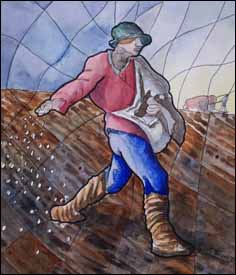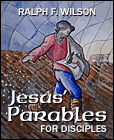
|
Old Testament
New Testament
Gospels
Acts
Paul's Letters
General Letters
Revelation
Topical Studies
Beginning the Journey (for new Christians). en Español

|
Old Testament
New Testament
Gospels
Acts
Paul's Letters
General Letters
Revelation
Topical Studies

|
Home
Bible Studies
Articles
Books
Podcasts
Search
Menu
Donate
About Us
Contact Us
FAQ
Sitemap
Preface
 Ralph F. Wilson, detail of 'The Sower (after Millet)' (2023), original watercolor, 10 x 14 inches, private collection. Inspired by Jean-Francois Millet's 1850 painting. |
Jesus constantly framed his teachings in figurative terms. Mark tells us, "He did not say anything to them without using a parable." Why? Partly to veil his teachings so his enemies couldn't use them against him and partly to make them memorable for his disciples to ponder and pass on.
Indeed, one of Jesus' prime means of discipling was to use parables, analogies, and figures of speech of all kinds to capsulize Kingdom truths. Contained in these stories and analogies is a vast domain of teaching designed to change lives.
My goal in this study is to help form you as a follower, a disciple of Jesus by helping you understand these same parables that Jesus used to form the first disciples -- and to help you apply them in your life today.
This study is different. Most books on the parables cover 25 to 35 of the best-known teaching parables such as the Good Samaritan, the Prodigal Son, and the Sower, but exclude many others. They look mainly at parables that contain "stories," but tend to exclude figurative analogies such as the Parable of the Vine and the Branches and the Parable of the Good Shepherd and the Sheepgate.
It comes down to definitions. You can define a parable as a story that illustrates a spiritual truth; that's how the English dictionary defines it. But when you consider the Greek and Hebrew words that describe figurative speech (Greek parabolē and Hebrew māshāl), you find that a truly biblical definition of parabolē is much broader than just stories. A biblical definition would include stories and allegories, of course, but also comparisons, similitudes, and maxims of all kinds.
Rather than see the essence of a parable in terms of a story, we should look at a parable in terms of comparison -- sometimes in stories, other times in similes, metaphors, and simple analogies. They are illustrations that illuminate spiritual truths by comparing them with commonly observed situations and objects.
The effect of adopting a truly biblical definition is significant. Now, instead of two or three dozen parables, we find more than 100 stories, analogies, and sayings that Jesus used to train his disciples -- much truer to the breadth and depth of Jesus' own training of his disciples.
This series of 12 lessons is designed to explore essentially all of Jesus' parables, analogies, and sayings. We'll also survey three of Jesus' powerful acted parables. Some we'll examine in detail, others more briefly. Our guiding principle is how central a parable or analogy is to Jesus' mission of building disciples for the Kingdom. (A few additional parables and analogies are included in an appendix for the sake of completeness.)
 Available in paperback, PDF, and Kindle formats |
Each parable or analogy is placed in its context and historical setting, then mined for the gold that Jesus' intended for his first disciples -- and for us today.
I invite you on a 12-week internship with the Master as we take a deep dive into Jesus' Parables for Disciples.
Pastor
Ralph
Loomis, California
September 1, 2023
Copyright © 2026, Ralph F. Wilson. <pastor![]() joyfulheart.com> All rights reserved. A single copy of this article is free. Do not put this on a website. See legal, copyright, and reprint information.
joyfulheart.com> All rights reserved. A single copy of this article is free. Do not put this on a website. See legal, copyright, and reprint information.


 To be notified about future articles, stories, and Bible studies, why don't you subscribe to our free newsletter, The Joyful Heart, by placing your e-mail address in the box below. We respect your
To be notified about future articles, stories, and Bible studies, why don't you subscribe to our free newsletter, The Joyful Heart, by placing your e-mail address in the box below. We respect your